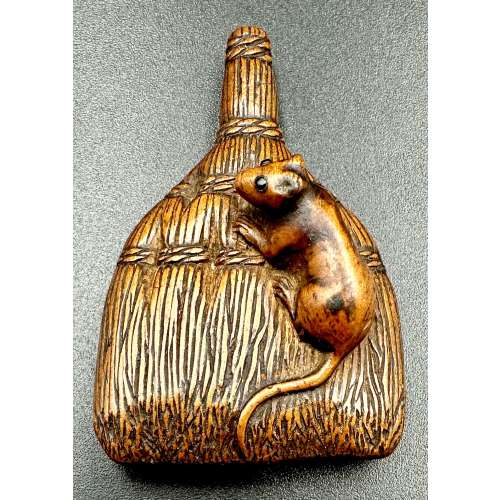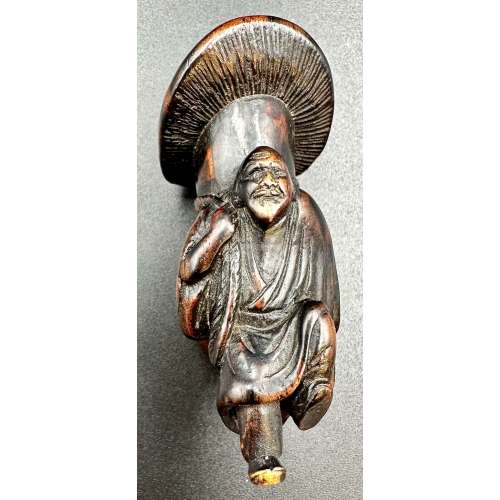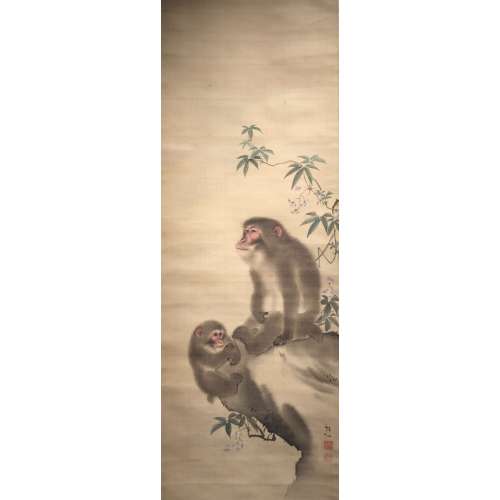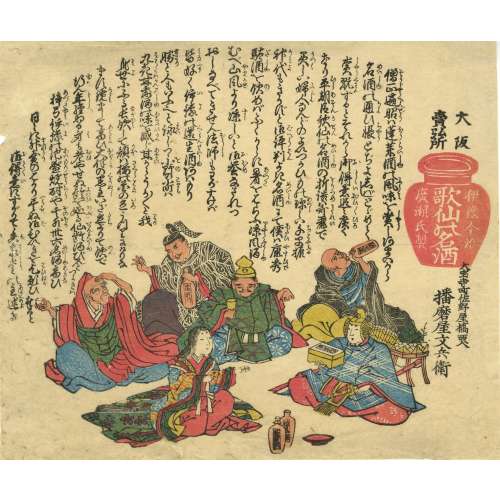-
 NEWFinely carved as a rat (nezumi) seated on a shuro brush, bound naturalistically with thick bristles. The rodent with a long trailing tail and eyes inlaid in a dark horn. Generously excavated, asymmetrical himotoshi to the underside. According to Merrily Baird (Symbols of Japan, p. 156): …The Japanese do not clearly differentiate between the rat and the mouse, and one word, nezumi [鼠], designates both. …Rat is a messenger of Daikokuten, a deity of grain and vegetation who is one of Japan’s Seven Gods of Good Luck. ...Depictions of the rat are most common in years of the zodiac represented by the animal. Late 18th century. Dimensions: 49 x 33 x 16 mm. Provenance: From the private collection of Armand Basi (Spanish, 1924-2009).
NEWFinely carved as a rat (nezumi) seated on a shuro brush, bound naturalistically with thick bristles. The rodent with a long trailing tail and eyes inlaid in a dark horn. Generously excavated, asymmetrical himotoshi to the underside. According to Merrily Baird (Symbols of Japan, p. 156): …The Japanese do not clearly differentiate between the rat and the mouse, and one word, nezumi [鼠], designates both. …Rat is a messenger of Daikokuten, a deity of grain and vegetation who is one of Japan’s Seven Gods of Good Luck. ...Depictions of the rat are most common in years of the zodiac represented by the animal. Late 18th century. Dimensions: 49 x 33 x 16 mm. Provenance: From the private collection of Armand Basi (Spanish, 1924-2009). -
 NEW
NEWNetsuke with a design of an old man carrying a giant mushroom on his back. Possibly signed on his left foot. According to Merrily Baird (Symbols of Japan, page. 93): ... This prominent use in the symbol-rich netsuke art form, however, reflects more their sexual symbolism than either their dietary appeal or interesting shapes. Mushrooms in Japan are generally a symbol of fertility, with some flat varieties, like shiitake, being associated with females. In contrast, the matsutake mushroom (Armillaria edodes) is a phallic symbol, as befits its thick, spearlike stem and the fact that it is consumed before cap opens.
Seller's description: "The old man carved walking, with one foot slightly raised, wearing a loose fitted robe and carrying a large long-stemmed mushroom on his back. The wood stained and bearing a fine patina. Himotoshi through the mushroom stem". See VO-0270.2018 for the same subject. Late 18th century. Dimensions: 62 mm tall -
 Mori Sosen (1747-1821). A Monkey Seated on a Rock with an Infant Monkey. Hanging scroll painting. Ink and colour on silk. Signed: Sosen. Sealed: Sosen. 108.3 x 38.3 cm. Provenance: According to the box inscriptions, the painting was in the possession of Itakura Katsunao, a daimyo lord in present-day Gunma, in 1808. In 1881, the painting was subsequently acquired by Negishi Shôrei (1833-1897) a master swordsman who established the Negishi school of shuriken ("The only specialist school to have survived is the Negishi-ryū, which was founded by Negishi Shorei in the mid-1800s".)
Mori Sosen (1747-1821). A Monkey Seated on a Rock with an Infant Monkey. Hanging scroll painting. Ink and colour on silk. Signed: Sosen. Sealed: Sosen. 108.3 x 38.3 cm. Provenance: According to the box inscriptions, the painting was in the possession of Itakura Katsunao, a daimyo lord in present-day Gunma, in 1808. In 1881, the painting was subsequently acquired by Negishi Shôrei (1833-1897) a master swordsman who established the Negishi school of shuriken ("The only specialist school to have survived is the Negishi-ryū, which was founded by Negishi Shorei in the mid-1800s".) -
 An uncut fan print uchiwa-e, size 22.7 x 28.7cm, by an unknown artist.
An uncut fan print uchiwa-e, size 22.7 x 28.7cm, by an unknown artist.


